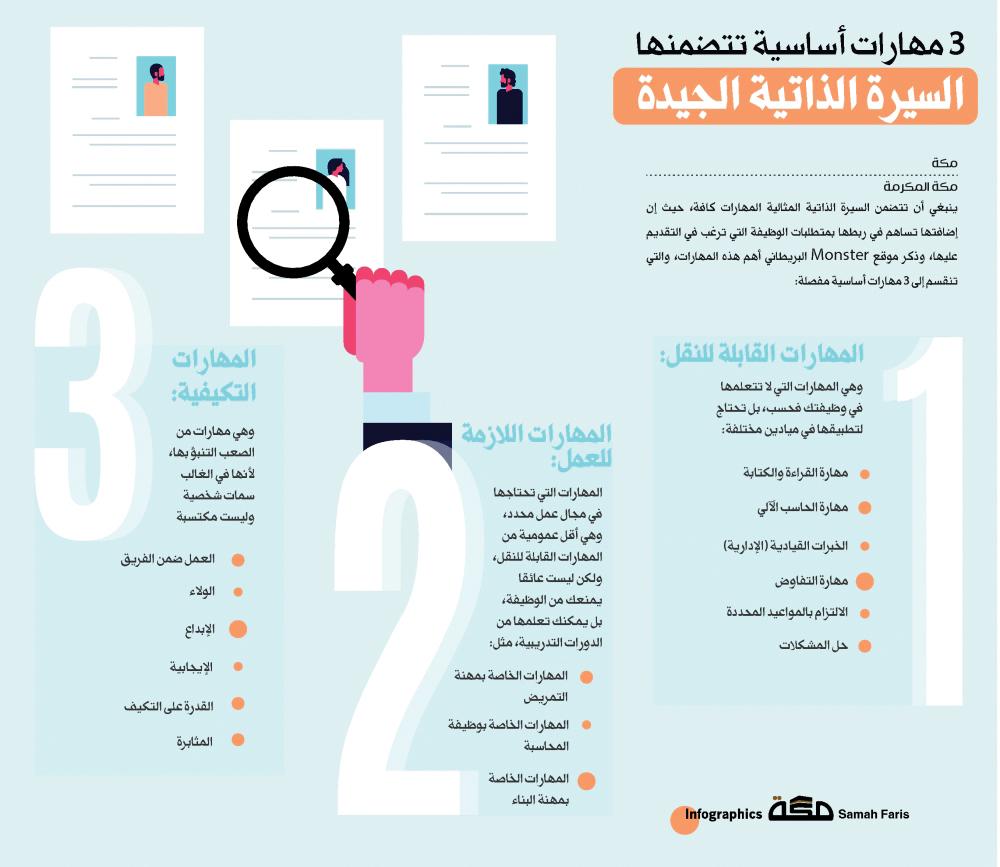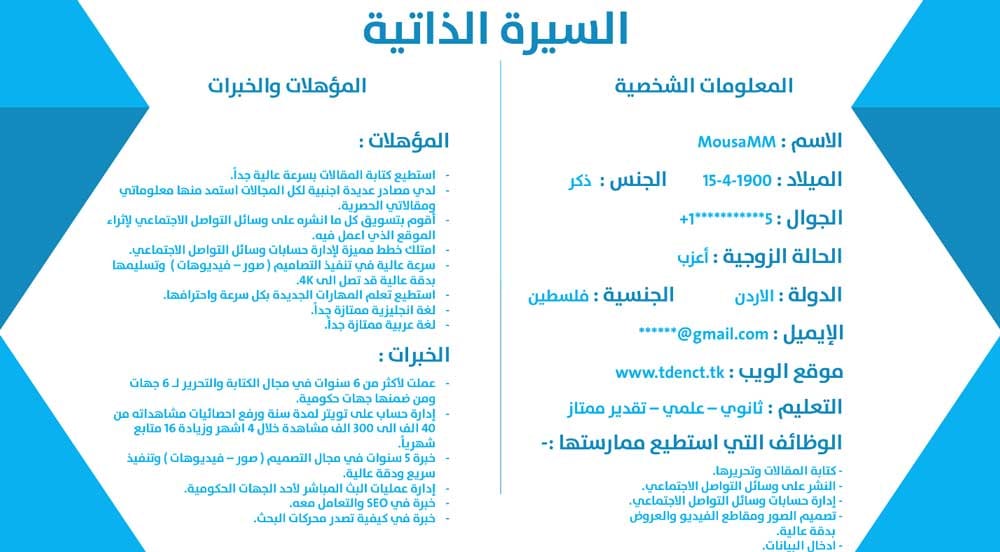Make a CV
Creating a professional resume is an important step in achieving your career goals.
It is important that the CV is organized and divided into appropriate sections.
The most important of these sections is personal details, where basic information about you should be included.
Then, you can add a summary or career objective that highlights your capabilities and career goals.
Make sure to include the work experience and educational qualifications you have.
You can also add the certificates and courses you have completed, along with mentioning the practical and personal skills you have.
Don't forget to mention the languages you speak, hobbies and personal interests.
Look for programs or websites that provide free templates to create a professional resume and choose the best one for you.
Be precise and organized in designing your CV and make it reflect your competence and skills in a professional and attractive way.
Steps to write a CV
First, a person should start by gathering the information required to create a resume.
This includes collecting personal data such as name, contact information and address.
In addition, you should write a short summary explaining what you want from the job and what distinguishes you from others.
Next, one should organize the section on education and academic qualifications.
This includes writing down any academic certificates you hold and a detailed description of the subjects you studied and the grades you achieved.
You can also add any additional training certificates or educational courses you have taken.
Next, work experiences should be arranged in an organized and attractive way.
This section should include the names of the companies you worked for and how long you spent in each job, as well as a detailed description of the tasks you performed and the accomplishments you achieved in each job.
Next, you should include a section on skills, which outlines the technical and soft skills you possess.
You must specify the skills related to the field of work in which you aspire to work, and linguistic, information and communication skills must also be mentioned.
Finally, you must check the spelling, grammar, and formatting of the CV.
You must review and ensure that there are no spelling errors, and use an appropriate format that makes it easy to read and understand.
Appropriate tables and formatting can be used to achieve this goal.
Examples of different CV designs
There are many examples of different resume designs that can be used to effectively highlight your skills and experience.
One common example is the chronological resume design, where experiences and skills are organized according to dates to show career development and growth over time.
In addition, there is also a functional resume design that focuses on skills and achievements rather than on previous experiences.
Moreover, academic resume design can be used for people who want to highlight the academic degrees and certificates they have obtained.
Additionally, a creative resume design can be used for people who work in creative industries such as graphic design or visual arts.
There are many different resume designs that can be used depending on your needs and the field of specialty in which you work.

Tips for writing a strong and attractive CV
- Start with a strong summary: The beginning of your CV should contain a short, strong summary that highlights your key experiences and skills.
Use strong words and briefly review your past accomplishments. - Defining career goals: Clearly define your career goals in your CV.
Mention the industry you would like to work in and the career path you would like to achieve.
This helps employers understand your career vision. - Focus on past experiences: Specifically detail previous jobs you have done.
List the responsibilities you have and the accomplishments you have achieved in each job.
Use numbers and statistics to illustrate the importance of your past contributions. - Highlight key skills: Point out key skills that can impact your professional performance positively.
Mention the technical, linguistic and social skills you possess.
Try to use specific examples to show how you apply these skills in real-life contexts. - Include education and training courses: List your academic education and professional training courses and certifications you have completed.
Try to highlight courses that relate to your target industry and that increase your experience and competence. - Flexibility and adaptability: Show your employer that you are a flexible person who is willing to adapt to diverse work environments.
Talk about your experiences working in multicultural teams or projects that require dealing with different challenges. - Proofreading and formatting: Review the CV carefully before submitting it.
Make sure it is free of grammatical errors and is readable and understandable.
Format your resume neatly and use headings, paragraphs, and exclamation marks if appropriate.

Steps to apply for a job using a CV
The steps to apply for a job using a CV include several important steps.
First, personal data must be written, such as full name, date of birth, and place of birth.
Then the academic qualifications must be written, summarizing the academic level and obtained certificates.
Next, previous work experiences must be written, where details of previous jobs and professional experiences are put.
Next, interests and achievements should be written, mentioning notable skills and achievements.
Finally, the skills related to the required job must be written.
The CV must be up-to-date and distinctive to increase the chances of getting the desired job.
Common mistakes in writing a CV and how to avoid them
- Unformatted: It is important that the resume format is clean and organized.
Clear fonts and appropriate font size should be used.
Different sections can be used such as Summary, Education, Work Experience and Skills.
Use a table to organize information and make it more readable. - Linguistic errors: Grammar, spelling, and correctness of sentences must be checked before submitting the CV.
Use helpful tools such as dictionaries and spell-checking programs to make sure there are no errors, such as errors in sentence structure or pronouns. - Excessive length: The CV should be concise and focused on the most important key points.
Avoid writing about unnecessary details or long dates.
Cluster points can be used to group and clarify information in a simple and effective manner. - Do not customize the CV for each job: The CV must be modified to suit the requirements of the specific job.
You can highlight the relevant skills and experience for the target job and avoid including unnecessary information. - Failure to provide correct contact information: Make sure that your personal information is up to date and correct.
Provide a phone number and email address that you can easily reach, and avoid using unprofessional or outdated mailing addresses.
How to improve your CV to increase your chances of getting the desired job
- A good start: Write a strong introduction that provides a quick summary of your key experiences and qualifications.
Try to be clear and concise, focusing on relevant skills and experience that make you a strong candidate for the job. - Organized structure: Organize your resume well and choose a logical order of items.
Use headings, alerts, and short paragraphs to make them easier to read.
You can also use tables to organize information in a coordinated and beautiful way. - Focus on achievements: Show your past achievements clearly and exclusively.
Use numbers and statistics to highlight the impact of your work.
For example, if you increased sales by a certain percentage at your previous job, mention that accomplishment specifically. - Resume Customization: Customize your resume for each job you apply for.
Analyze the job requirements and write down some keywords and the skills and experiences that match them.
This helps make your resume stand out among other applicants and increases your chances. - Reliable References: Make sure to include reliable references on your CV.
It could be former co-workers or former department heads who can vouch for your skills and professionalism.
Ask for their permission to use them as references, and make sure you provide them with the correct contact information. - Formatting and Style: Make sure your resume looks professional and visually appealing.
Use easy-to-read fonts and format the text well.
Use different headings, paragraphs, and lines to organize information neatly and smoothly.

Frequently asked questions about writing a CV
There are many frequently asked questions about writing a CV.
One of the most prominent questions is how to start writing a CV.
When a person decides to write his or her autobiography, it may be difficult for them to get started.
It is important that he begins with a personal summary that reviews his most important personal information and what distinguishes him from others.
For example, he can mention his main skills, work and educational experiences.
Other frequently asked questions about writing a resume include: What is the best format to use? It depends on the person's preferences and the industry in which he works.
Many people use a reverse chronological format, starting with their most recent work experience and working up to their first.
You should also avoid overlapping or inconsistent formatting and pay attention to the format and chronology of information.
One of the other common questions is how long should a CV be? The CV should be brief, concise and within acceptable limits.
A CV is usually one or two pages long.
Each section should contain the basic and most important information in a clear and concise manner.
Finally, what is the best way to describe your previous job responsibilities? Description of previous job responsibilities must be specific, concise and effective.
Clear, specific words and phrases can be used to describe responsibilities and accomplishments.
Important details should be presented directly and concisely with emphasis on the results achieved and the contribution the person made in the previous job.

